Geodes are like nature’s surprise eggs, filled with sparkling crystals inside a plain-looking rock. Our state is a treasure trove for these hidden gems, with its many different landscapes that make it perfect for rock hounds.
If you’re itching to crack open your own crystal-filled wonder, you’re in the right place!
This article will show you the best spots in our state to find geodes. We’ll also share some handy tips to make your geode hunting adventure a success.
So grab your hammer and get ready to discover the beauty hiding in ordinary-looking rocks all around this state!
How Geodes From Here

Geodes form when bubbles in volcanic rocks or spaces in sedimentary rocks get filled with minerals over time.
First, water rich in minerals like quartz or calcite seeps into the hollow space. As the water evaporates, it leaves behind the minerals, which slowly build up layer by layer.
Eventually, these minerals create a crystal lining inside the geode. The outer shell stays rough, while the inside becomes a sparkling treasure.
The process can take thousands, even millions, of years, making each geode a unique and beautiful time capsule of Earth’s natural forces.
The Types Of Geodes Found in the US
There are many fascinating varieties of geodes that can be found across the United States, including in our own state. Each type is distinctly beautiful and intriguing:
Amethyst Geode

Amethyst geodes look plain on the outside, like a potato. But crack them open, and you’ll find stunning purple crystals. These crystals can be light lavender or deep purple.
The structure of crystals inside can vary widely. Some are tiny and densely packed, creating a sparkling surface. Others form large, distinct points that jut inwards.
The color range is impressive too, from pale lilac to deep royal purple. Some amethyst geodes develop unique features. “Stalactites” of amethyst might hang from the top.
In rare cases, you might find a water bubble trapped inside, a remnant from the geode’s formation millions of years ago.
Citrine Geode

Citrine geodes are eye-catching rocks with golden yellow to orange crystals inside. They sparkle when light hits them, looking like sunshine trapped in stone. The colors come from iron mixed in with the quartz.
Unlike many gemstones, citrine’s color is often evenly distributed throughout the crystal.
Most citrine on the market isn’t natural. It’s actually heat-treated amethyst. This process turns the purple amethyst into vibrant citrine. Natural citrine is rarer and often has a more subtle color.
Pyrite Geode

Ever cracked open a rock and found gold inside? Well, not real gold, but something that looks just like it. That’s a pyrite geode. Pyrite is called “fool’s gold” because it’s so shiny and golden.
Inside these geodes, pyrite forms in cool shapes. Sometimes it’s perfect cubes. Other times its clumps or even round balls called “pyrite suns”.
Pyrite has a fun history. People have been mixing it up with real gold for thousands of years. That’s how it got its nickname.
Selenite Geode
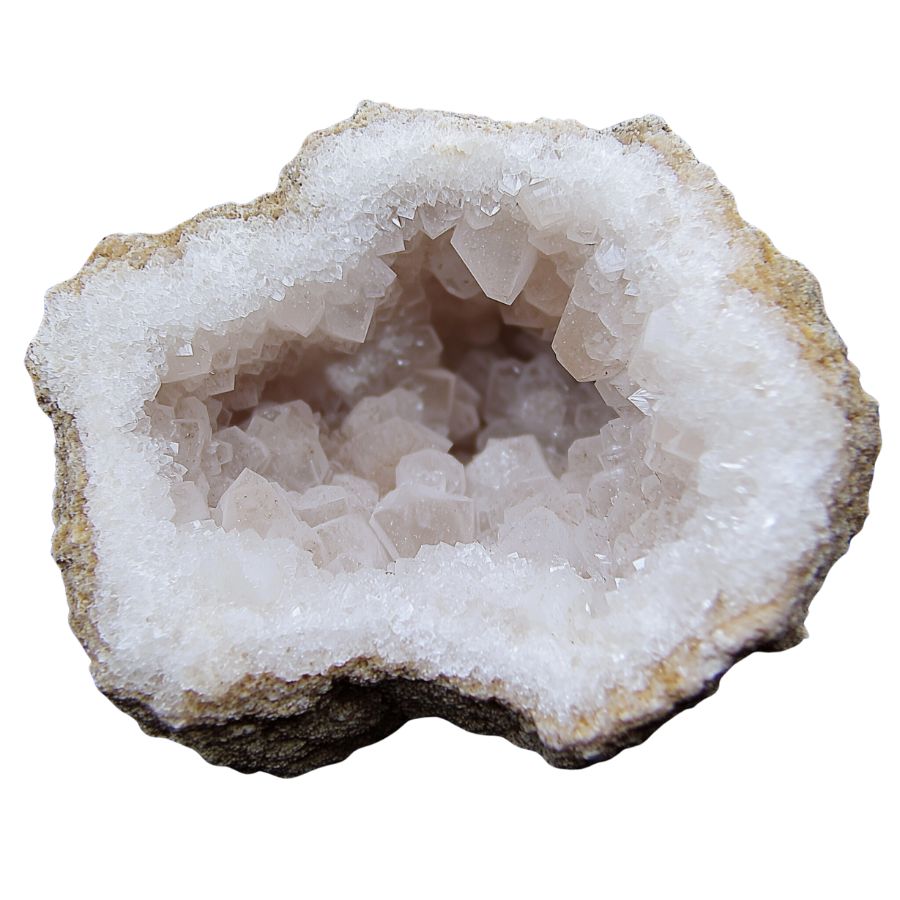
Selenite geodes stand out from the crowd. They’re white and see-through, with a glassy look. When you open one up, you’ll see crystals that look like they’re made of ice or moonlight.
Unlike harder geodes, selenite is soft. You can scratch it with your fingernail! This softness means you need to handle it carefully. But it also means selenite can be shaped into beautiful forms easily.
One cool thing about selenite is how it plays with light. Hold it up to a lamp, and you’ll see the light shine right through it. This makes selenite geodes popular for decorative lamps and light fixtures. They add a magical glow to any room.
Celestite Geode

Celestite geodes are like pieces of sky trapped in rock. Their crystals are typically a delicate blue, ranging from almost colorless to deep sky blue. In rare cases, celestite can form in other colors. Pink celestite is highly prized by collectors.
One unique feature of celestite is its perfect cleavage. This means the crystals can be easily split into rhombohedral shapes.
These geodes form in a unique way. They start as nodules of a soft mineral called alabaster. Over time, this dissolves and is replaced by celestite crystals. Some celestite geodes are huge, like the famous Crystal Cave in Ohio.
Celestite isn’t just pretty to look at. It’s used to make strontium, an element with many uses. You’ll find strontium in fireworks, where it creates red colors. It’s also used in making TV screens and ceramics.
Jasper Geode
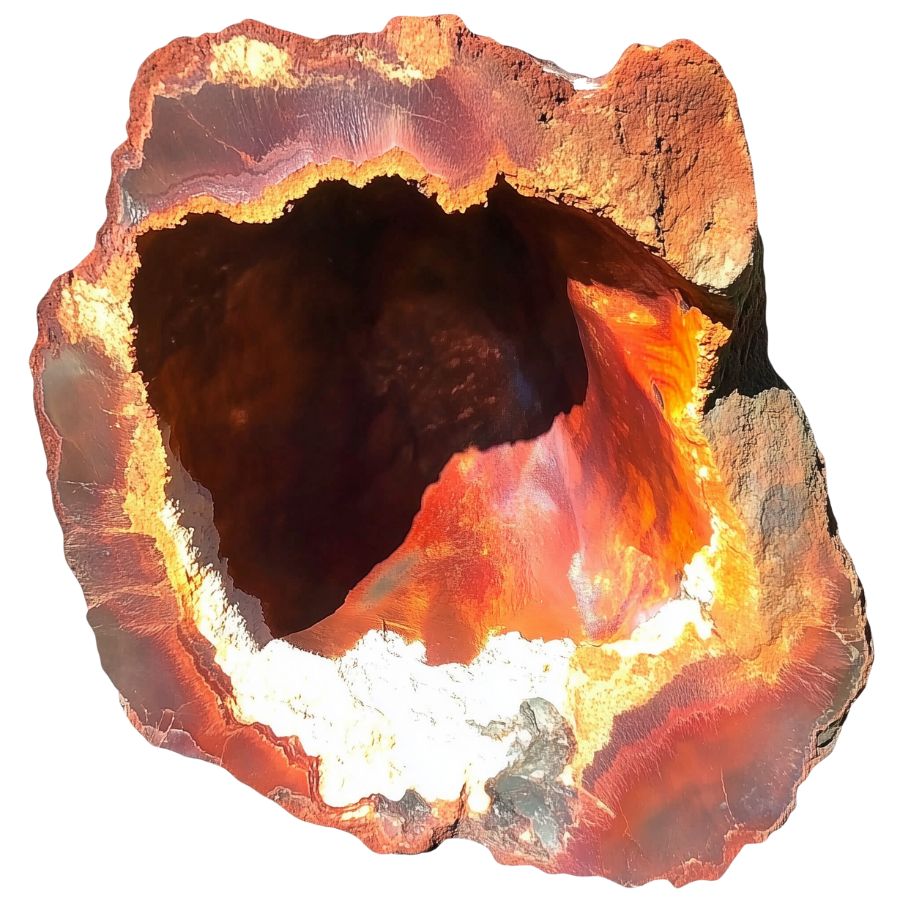
Jasper geodes are the chameleons of the mineral world. They can appear in almost any color, often with multiple hues in a single specimen. Patterns can range from solid colors to intricate swirls, bands, or spots.
One fascinating type is picture jasper. These geodes contain patterns that resemble landscapes, with “skies,” “mountains,” and “rivers” visible in the stone. Each one is like a miniature painting created by nature.
Some jasper geodes contain orbicular patterns – spherical structures that formed as the jasper solidified. These create eye-catching bull’s-eye or flower-like designs in the stone, making each piece truly one-of-a-kind.
Carnelian Geode

Carnelian geodes have vibrant orange to reddish-brown colors. They can be somewhat see-through, which makes them look even more interesting. The bright colors come from the iron in the stone.
These geodes stand out from other similar stones. They’re brighter than sard, which is usually darker and more brownish. And unlike agate, carnelian doesn’t have bands or stripes.
Carnelian has been popular for a long time. Ancient Egyptians and Greeks used it to make special rings. It’s tough enough for everyday jewelry.
Some people heat or dye carnelian to make its color even brighter. This makes it a favorite for both rock collectors and jewelry lovers.
Fluorite Geode

Fluorite geodes are like nature’s rainbow. They come in many colors – purple, green, blue, yellow, and sometimes even clear or black. When you open one up, you might see cube-shaped or eight-sided crystals inside.
What makes fluorite special is that you can often see more than one color in a single stone. This is different from many other geodes. Also, fluorite has a unique way of splitting when it breaks.
A cool fact: fluorite glows blue under ultraviolet light. This was first discovered back in 1852. Because of its many colors and this glowing ability, fluorite is sometimes called the “most colorful mineral in the world.”
Scolecite Geode

Scolecite geodes are like tiny crystal caves. They’re usually white or colorless, but sometimes you might find pink, yellow, or green ones.
What makes them special is the crystals inside. They look like thin needles or delicate hairs, all pointing out from the center.
These geodes are different from others because of their crystal shape. Instead of blocky or chunky crystals, scolecite has these fine, hair-like ones. This gives them a unique, delicate look.
Scolecite has an interesting property – it can hold a lot of water in its structure. This means it can absorb and release water easily. This makes scolecite useful in various ways, not just as a pretty rock to look at.
Apophyllite Geode

Apophyllite geodes are like nature’s disco balls. They often have dark or black crystals inside a hollow rock. These crystals can be see-through or slightly cloudy, with cube-like or flat shapes.
What makes apophyllite geodes stand out is how the crystals form. They grow in round clusters that look like tiny disco balls. This unique formation is rare and makes them special to rock enthusiasts.
Collectors really prize these “disco ball” clusters. They’re not common, which makes them valuable to people who love unusual rocks. The way apophyllite crystals catch and reflect light adds to their appeal, making them fascinating to look at and study.
What Rough Geode Looks Like
Identifying a rough geode might seem tricky, but with a few tips, you can spot one even if you’re not a rock expert. Here’s how you can do it.
Look for a Rounded Shape

A rough geode often has a rounded or egg-like shape. It might not be perfectly round but look for a generally bulbous form.
When you’re out searching, skip the flat, jagged rocks. Geodes usually have smoother exteriors because they’ve been rolling around in rivers or other environments for a long time.
Check for a Dull, Bumpy Surface

The outside of a geode isn’t usually shiny. Instead, it’s dull, bumpy, and a bit rough.
Imagine a potato or a clump of dirt with some bumps and dents. That’s how a geode might look before it’s cracked open.
The outside won’t give away much of what’s inside, so don’t be fooled by its ordinary appearance.
Test the Weight

Pick up the rock. Does it feel lighter than it looks? That’s a good sign!
Geodes are hollow or partially hollow, which makes them lighter than solid rocks of the same size. If it feels unexpectedly light, you might have found something special.
Look for Tiny Crystals or Mineral Patches

Sometimes, you can spot small crystals or mineral deposits on the outside. These could look like tiny sparkles or specks of color.
While the outside of a geode is usually dull, a little peek of what’s inside might show through. Keep an eye out for these hints, especially if you’re in a known geode-rich area.
Tips on Where to Look
Once you get to the places we have listed below there are some things you should keep in mind when you’re searching:
Explore Riverbeds and Streams
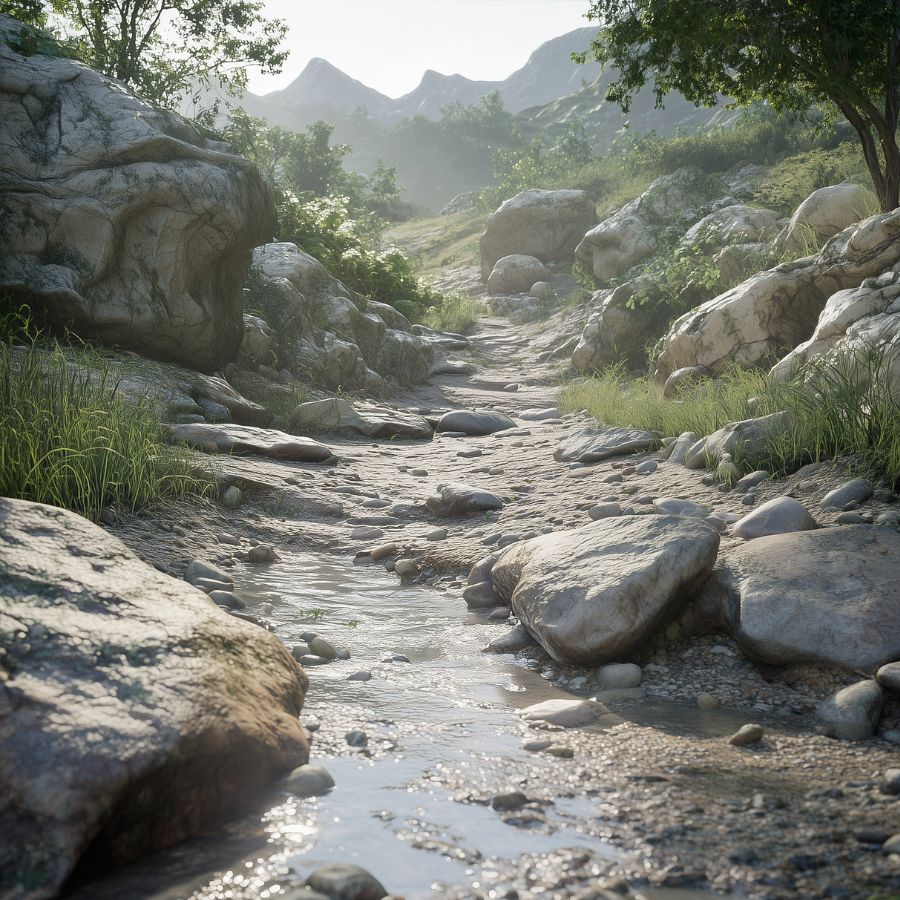
Geodes often form in riverbeds or streams. Water flow smooths out their rough edges and deposits them in these areas.
When exploring, focus on gravel bars or the edges of rivers where rocks naturally gather.
Search in Sedimentary Rock Layers

Sedimentary rocks, like limestone, are prime spots for geodes. These rocks form in layers over time, trapping minerals inside.
Look for areas where sedimentary rocks are exposed, such as cliffs or road cuts.
Visit Old Mines or Quarries

Abandoned mines and quarries are excellent spots for geode hunting.
Workers often missed geodes while digging for other materials. Explore the tailings or leftover rock piles for hidden treasures.
Explore Hills and Rock Outcrops

Hills and rocky outcrops often reveal geodes. As erosion wears away the softer rock, it exposes the harder geodes.
Look for areas with exposed rocks and keep an eye out for rounded shapes.
The Types Of Geodes Found In Kentucky
There are several different types of geodes found around the world. What it looks like and what a geode is worth depends a lot on what type of crystal it’s made from. Here in Kentucky, you will be able to find:
- Calcite geodes
- Chalcedony geodes
- Quartz geodes
The Best Places To Find Geodes in Kentucky
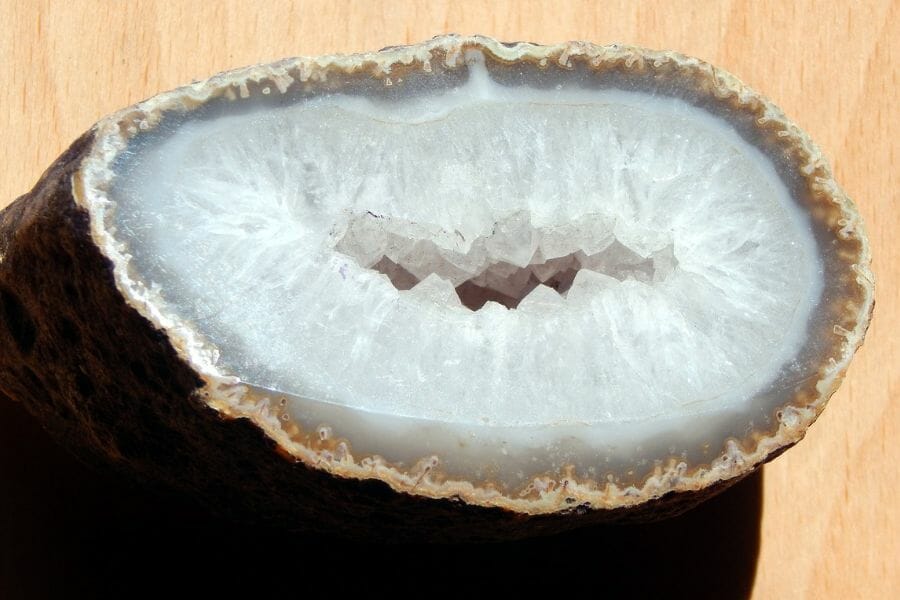
To start things off we’re going to share our absolute favorite places to find Kentucky geodes. There are plenty of great places to mine gems in Kentucky but only a few of them are great for what we’re after. Some of these places are not very well known but they have been consistently good options when we’ve been searching.
Always Confirm Access and Collection Rules!
Before heading out to any of the locations on our list you need to confirm access requirements and collection rules for both public and private locations directly with the location. We haven’t personally verified every location and the access requirements and collection rules often change without notice.
Many of the locations we mention will not allow collecting but are still great places for those who love to find beautiful rocks and minerals in the wild without keeping them. We also can’t guarantee you will find anything in these locations since they are constantly changing.
Always get updated information directly from the source ahead of time to ensure responsible rockhounding. If you want even more current options it’s always a good idea to contact local rock and mineral clubs and groups
The banks and bends of the Green River
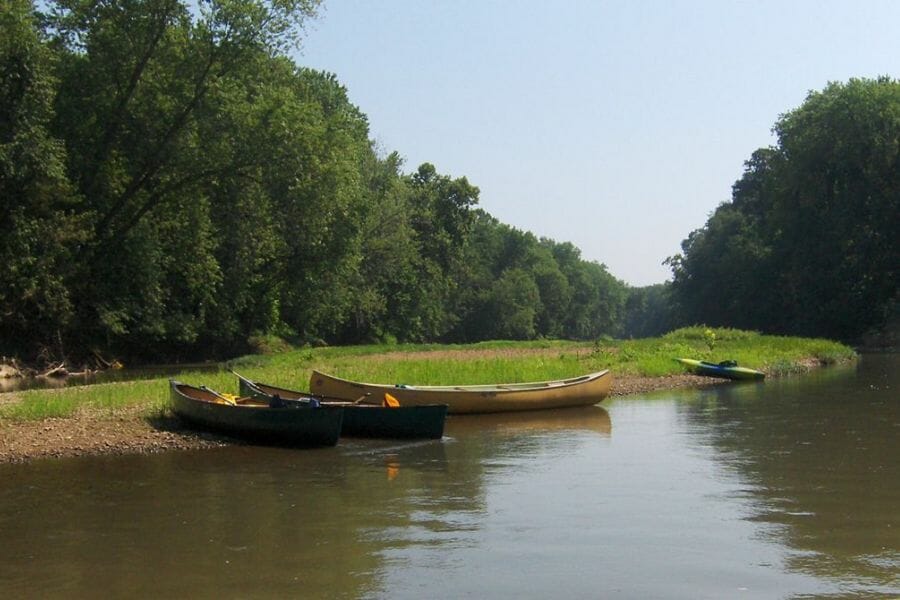
The Green River is a 733-mile long tributary of the Ohio River that flows through Kentucky. It is one of the most important rivers in the state, providing drinking water for over one million people, and serving as an important transportation route for industry and recreation. It’s also one of the best places we’ve found to find geodes.
It has also been designated a National Wild and Scenic River which means there are plenty of places to explore that haven’t been developed. Pay particular attention to the banks and bends of the river, especially when they have dried out, when searching for geodes. The river’s watershed supports a variety of industries such as coal mining, timber harvesting, tourism, and agriculture which often include activities that dig up the ground and expose geodes.
Before you bring anything home with you make sure that you’ve read up on the most recent collection guidelines from the State of Kentucky.
Where we found geodes on The Green River
Pay special attention to any dry areas near the banks and bends of the river. The river is constantly digging up and redepositing new geodes. The best times to find them can be after big rains and during droughts when new areas of the river are exposed.
DON'T MISS OUT ON ANY GREAT FINDS!
While you're out searching for Geodes you're going to find a lot of other interesting rocks and minerals along the way. The last thing you want to do is toss out something really interesting or valuable. It can be easy to misidentify things without a little guidance.
We've put together a fantastic field guide that makes identifying 140 of the most interesting and valuable rocks and minerals you will find REALLY EASY. It's simple to use, really durable, and will allow you to identify just about any rock and mineral you come across. Make sure you bring it along on your hunt!
Rockcastle County

Now, recommending an entire county can be pretty bold but there are several really great spots in Rockcastle County that are worth mentioning. Rockcastle is located in the southeastern part of the state and is situated between two mountain ranges, the Cumberland and Pine Mountains.
The area was originally inhabited by Native Americans and was later explored by Daniel Boone in 1769. The county was formed in 1810 from parts of Lincoln and Pulaski counties. Rockcastle County has a rich history with many multiple state parks that are fun to hunt for geodes in.
The economy of Rockcastle County is primarily based on agriculture and forestry which often turn up the ground and offer opportunities to find geodes.
Where we found geodes in Rockcastle County
While you can find geodes all over the county there are a few spots that are particularly good:
- The Boone area around the abandoned limestone quarry
- Along Roundstone Creek, especially when the water is low
- All along the road cut for US-25 toward Mount Vernon
- The West Side of Mount Vernon around the Kentucky Stone Company Quarry
- Around Mullins State, especially near the Kentucky Stone Company Quarry
Kentucky Lake

Kentucky Lake is a man-made lake located in the western part of the state that was created by the Tennessee Valley Authority (TVA) in 1944 when they dammed the Tennessee River in order to create a hydroelectric power plant. It is the largest artificial lake east of the Mississippi River and covers over 160,000 acres and is bordered by four counties – Marshall, Lyon, Calloway, and Trigg.
The area around Kentucky Lake has several state parks and wildlife management areas which provide plenty of opportunities for exploring and searching for geodes.
Where we found geodes at Kentucky Lake
The best area that we’ve found to find geodes has been on the south shore of the lake in Fenton County. We’ve had the best luck during dryer periods when the lake is low as well as after bigger storms.
The eastern shore of the lake can also be a good option.
Lincoln County
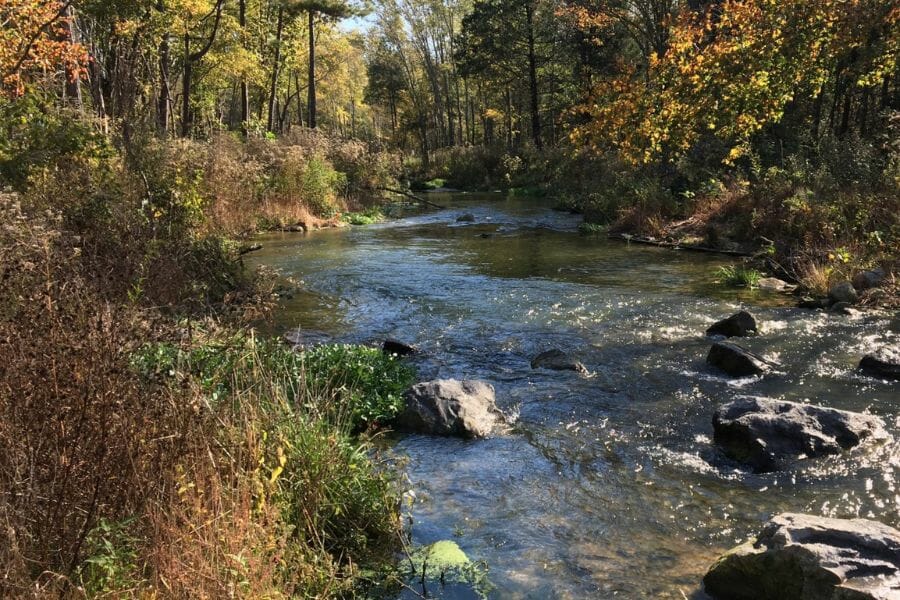
Lincoln County is another big area that has been great for locating geodes. Located in central Kentucky it’s home to the cities of Stanford and Hustonville.
The geology of Lincoln County is dominated by sedimentary rocks from the Mississippian and Pennsylvanian periods. The area contains limestone and shale formations that have been quarried for building material which has also left several mine dumps worth exploring. Additionally, there are deposits of coal in the county that are mined for energy production which also produce dumps worth exploring.
In terms of natural features, Lincoln County contains a variety of lakes and rivers including Herrington Lake, which is the largest man-made lake east of the Mississippi River. There are also numerous creeks throughout the county such as Dix River and Hanging Fork Creek that feed into larger bodies of water.
Where we found geodes in Lincoln County
While you can find geodes all over the county there have been a few spots that we have found to be especially good:
- The dry creek beds south of Crab Orchard Road in Crab Orchard
- The Halls Gap area downstream from the headwaters of the Green River
- The mine dumps of the various abandoned quarries
Madison County
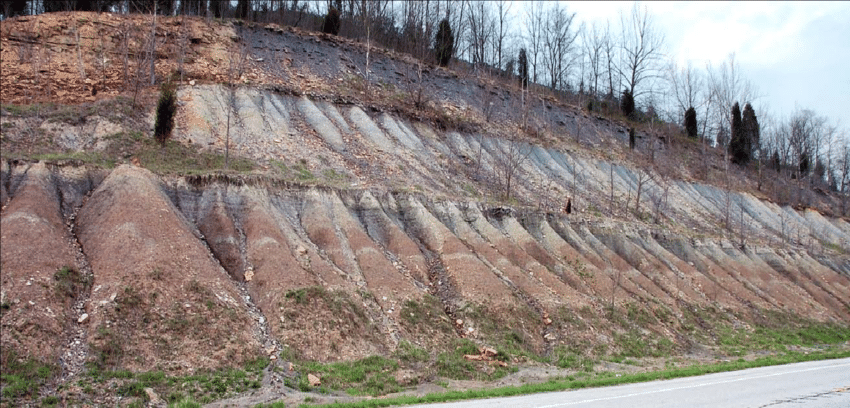
Located in the heart of Kentucky, Madison County is part of the Bluegrass Region. Like other areas in the region, the geology here includes limestone, shale, and sandstone formations that were deposited during several periods of time in Earth’s history. The oldest rocks are from the Ordovician Period (500 million years ago)during which shallow seas covered much of Kentucky creating an environment that was ideal for coral reefs. These corals left behind a thick layer of limestone which can be seen throughout Madison County today.
In addition to these Ordovician limestones, Madison County also contains Silurian shales which were deposited during a time when shallow seas advanced and retreated across Kentucky leaving behind mud deposits that eventually turned into shale.
Overall Madison County has a diverse geology that has been very condusive to the creation of geodes. This geology has provided many resources over time including coal and oil deposits which have been mined well as valuable construction materials such as limestone which has been used for buildings and roads throughout the county. The leftover dumps from these mines can also be productive areas to find geodes.
Where we found geodes in Madison County
Anywhere you go in the county you’re probably not to far from a geode but there are a few places you should try first:
- The road cuts around Berea southeast on 25
- Mine dumps from the old and abandoned mines
- Dry streams and banks when the water is low
Other Great Places To Dig For Kentucky Geodes

Now that we have given you our favorite spots we wanted to give you the rest of our recommended spots. We’ll give you our recommendations by county and then some more general locations where we’ve had a lot of luck. For any recommendation where we say “county wide” we will provide more specific recommendations in the following section.
Our recommendations by county
| County | Location |
| Adair | County wide |
| Adair | The Shamrock Stone Company around Columbia |
| Allen | Scottsville area quarries |
| Anderson | County Wide |
| Barren | Cave City area quarries |
| Barren | Streams east of Glasgow |
| Boyle | County wide |
| Clark | County wide |
| Estill | County wide |
| Fayette | County wide |
| Garrard | County wide |
| Hardin | Elizabethtown area quarries |
| Hardin | Vine Grove area quarries |
| Jefferson | Road cuts around Muldraughs Hill in Valley Station |
| Jefferson | Beds and banks along the Green River near Hall’s Gap |
| Jessamine | County wide |
| Lincoln | County wide |
| Lincoln | Dry creekbeds south fo Crab Orchard Road in Crab Orchard |
| Lincoln | The Green River around Halls’ Gap South of Stanford |
| Lyon | The east shore of Kentucky Lake and in county road cuts |
| Lyon | The State Quarry near the Kentucky Dam |
| Madison | County wide |
| Madison | The road cuts on US 25 headed southest from Berea |
| Mercer | County wide |
| Monroe | Quarries and excavations around Tompkinsville |
| Powell | County wide |
| Rockastle | County wide |
| Rockcastle | Abandoned limestone quarry around Boone |
| Rockcastle | Roundstone Creek |
| Rockcastle | Road cuts along US 25 to Mount Vernon |
| Rockcastle | The Kentucky Stone Company Quarry to the west of Mount Vernon |
| The Kentucky State Stone Company Quarry near Mullins State | County wide |
| Trigg | The Fenton area on the south shore of Kentucky Lake |
| Woodford | County wide |
Common Geode-Hunting Questions
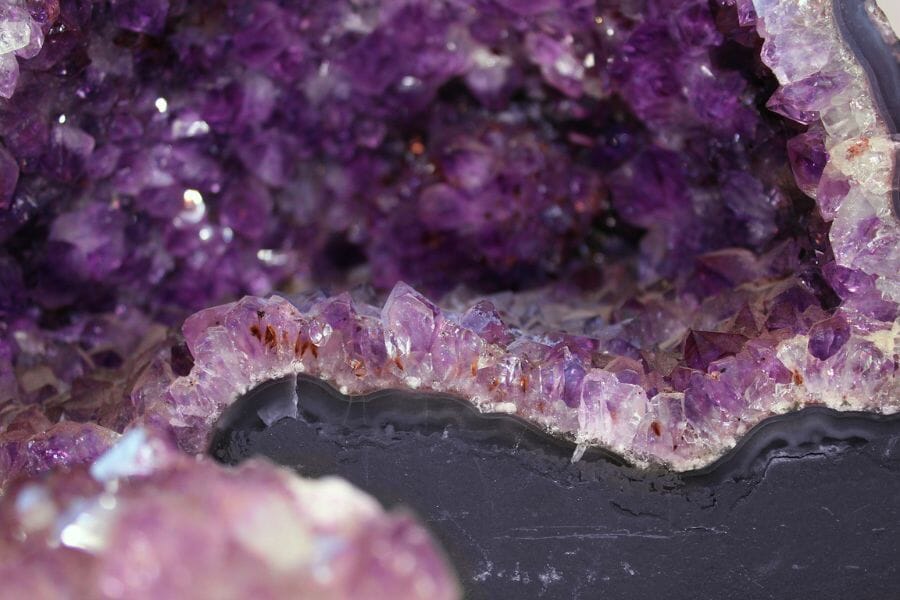
There are a few questions about searching for geodes in Kentucky that always come up and are worth answering here as well:
Where can you find amethyst geodes in Kentucky?
Finding an amethyst geode is a high point for many of us. Unfortunately, amethyst geodes do not occur naturally in Kentucky. The only place you will find one here is if you check out a great local rock and gem shop.
Is it illegal to collect geodes in Kentucky?
As long as you are obeying local collecting laws it is completely legal to collect geodes in Kentucky. Just be sure that you are observing any local regulations if you are on government land and getting permission if on private land.
The Best Places To Buy Geodes In Kentucky

Spending hours trekking out into the wilderness to find geodes isn’t for everyone. Sometimes you just want something beautiful for your collection or to put on your desk without all the effort.
These are our favorite local shops and other options to buy really cool geodes:
- Big Mike’s Rock Shop – 566 Old Mammoth Cave Rd, Cave City, KY 42127
- Amazon – Surprisingly there is actually a pretty good selection of geodes on Amazon. You can even find whole kits to for breaking open your own geodes including geodes to crack open.
- Nice Rock Shop – 311 Broadway St, Paducah, KY 42001
- Goldheart Stones and Such – 980 Barret Ave, Louisville, KY 40204
- Dimitridon Studios Rock Shop – 8321 E Main St, Alexandria, KY 41001
- Sun Stones – 1207 S 6th St, Louisville, KY 40203
Additional places to find geodes in nearby states
Check out our guides for nearby states if you’ve already tried all of our suggestions above or if you’re planning a trip outside of the state:
- Geodes in Ohio
- Geodes in Indiana
- Geodes in Illinois
- Geodes in Missouri
- Geodes in Tennessee
- Geodes in Virginia
- Geodes in West Virginia
If you have any recommendations for our list please leave a comment below!


